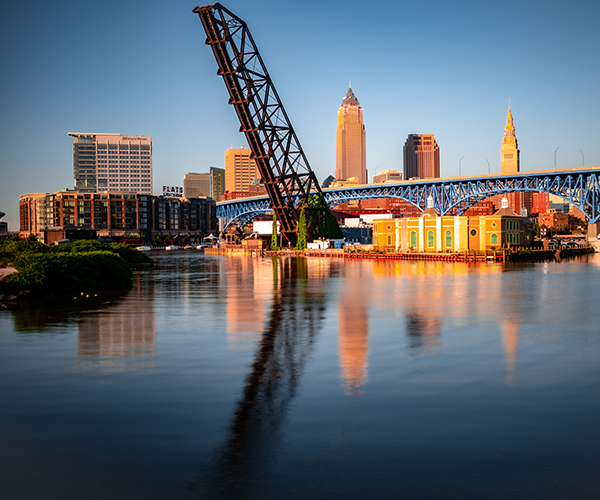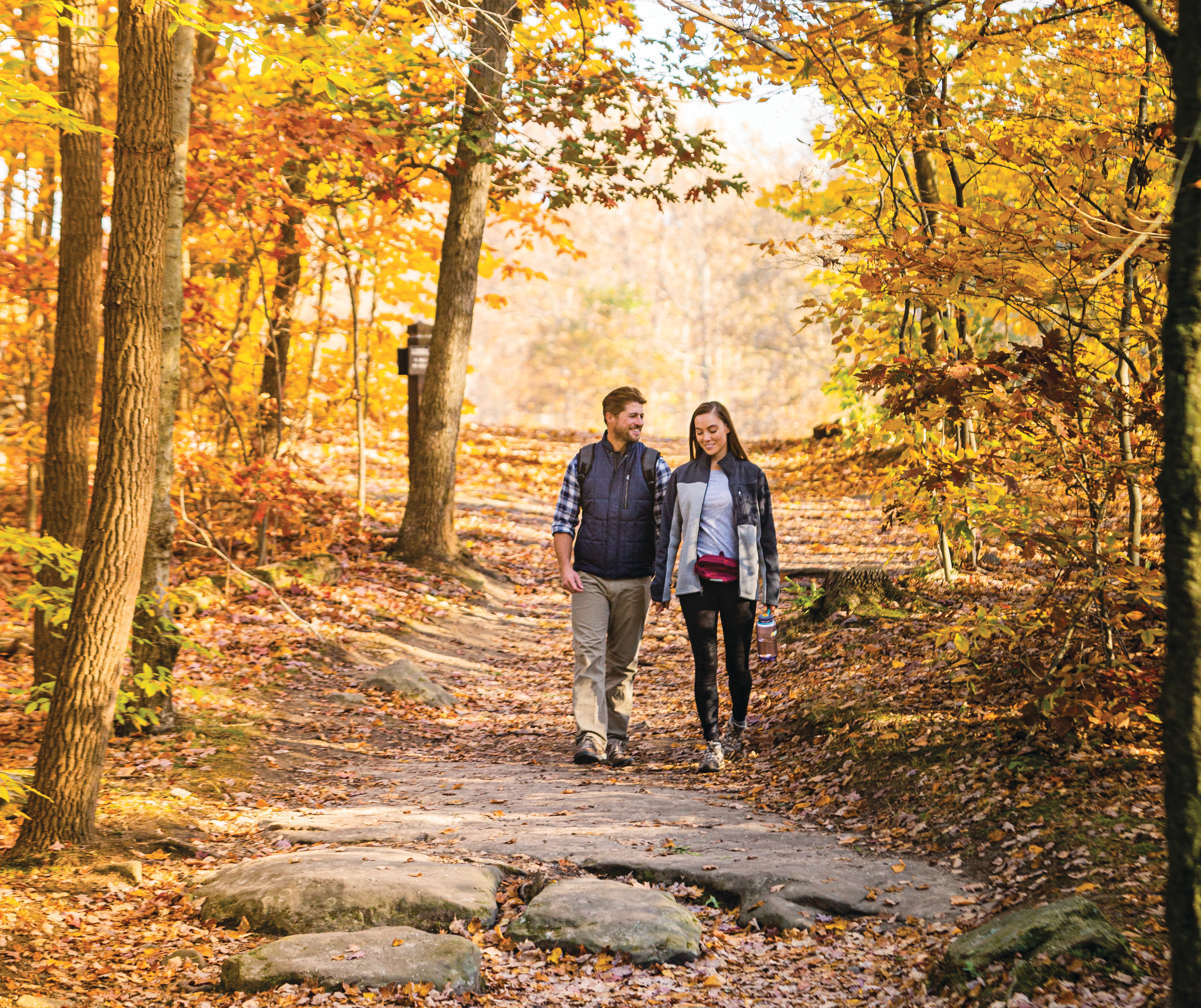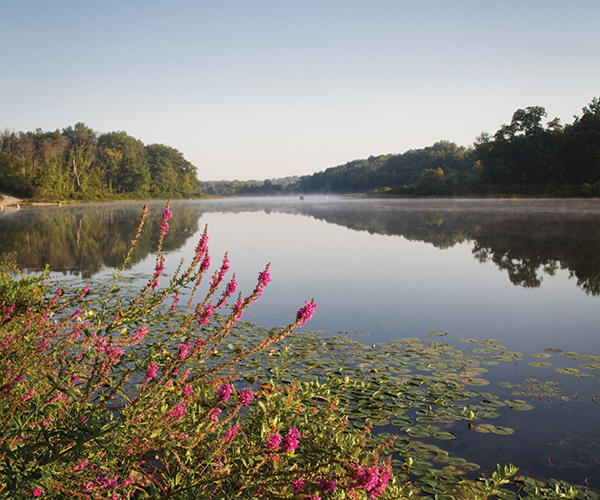Hollander's, Ann Arbor, Mich.
2 hours, 30 minutes
The cast-iron letterpress from he 1920s looks intimidating — it can give you a good pinch if you're not careful. But our instructor, Tom Hollander, leads us through the procedure: First ink the plate, which spreads color onto rollers, then position the paper carefully before drawing down the tall handle on the left, pressing the inked image onto the page. Voila! I have a beautifully inked image — a work of art.
Hollander's, in Ann Arbor, Mich., is the place to go for materials and classes related to book and paper art. It all began with Annette Hollander, one of the early supporters of the U.S. book art movement in the 1960s. Inheriting his mother's love for the craft, Tom began the business with his wife, Cindy, in their home then opened a little shop in Ann Arbor's Kerrytown district in 1991.
Today, Hollander's carries one of the largest collections of international decorative papers: Think Egyptian papyrus, Japanese silk-screen and Florentine prints embossed with powdered gold. Workshops cover a wide range and include bookbinding, calligraphy and encaustic (melted wax) painting. Recently, Hollander's added a culinary shop and kitchen with chef-led demonstrations and hands-on workshops such as wine and food pairing.
Classes are small, usually six to 12 students, and range from a few hours to several days, with prices starting around $30. The website has a full list and details. // Manya Kaczkowski
Hollander's, 410 N. Fourth Ave., Ann Arbor, Mich., 734-741-7531, hollanders.com
Elmwood Avenue, Buffalo, N.Y.
3 hours, 15 minutes
Well into fall, my husband and I take a Saturday morning stroll up Elmwood Avenue to the Bidwell Farmers Market. On the way, we grab a cup of coffee at Caffe Aroma and window-shop at the boutiques and galleries that line this main drag of Elmwood Village.
The village is one of Buffalo's busiest, prettiest neighborhoods. Frederick Law Olmsted, famous partly for designing New York City's Central Park, planned the parkway system, and streets are lined with landscaped Queen Anne, Italianate, Victorian and French Second-Empire homes (plus a Frank Lloyd Wright residence). Buffalo's burgeoning reputation as a gardening mecca is reflected in the many lushly landscaped, colorful Elmwood yards. The area is so appealing it was included in the American Planning Association's 2007 "10 Great Neighborhoods in America."
After lunch at Bistro Europa, a tiny, farm-to-table treat, my husband and I find there's also plenty of beauty inside approximately 200 businesses along about two miles of Elmwood Avenue. While I'm picking up a gift of artisan chocolates, I can't resist Chow Chocolat's handmade chocolate croissants. My throw pillows from Reimagine, owned by young go-getters Hayley Carrow and Cortney Morrison-Taylor, are perfectly representative of their mix of vintage furniture, original artwork and funky accessories. I linger at ShoeFly, where my husband and I both find chic shoes we can't get at the mall. Without a visit to the verve-filled neighborhood anchor, you haven't really shopped Elmwood. // Jana Eisenberg
Find a shopping map at elmwoodvillage.org.
Barns of Butler County, Butler County, Pa.
2 hours, 15 minutes
The old stone barn looking out over the fields is beautiful. The scene is reminiscent of the European countryside, and immediately, I'm whisked back in history.
I'm in front of the Drovers Inn Farm, one of the 16 barns on the Barns of Butler County tour. Built on land that was part of the Harmonist Society in the 1800s, the barn was a gift to Aaron and Elizabeth Schontz from her father, Abraham Zeigler, an early settler in Western Pennsylvania. The barn itself was crafted from stone, rocks that seemed to almost gleam during the morning of my visit.
Adding to the attraction of the view was knowing that each of the four silos has round date stones at each gable peak, inscribed with the couple's name, forever etched in time.
The self-guided tour leads through the beautiful hills of Butler County. Choose one of the three driving routes like I did, about three hours for each segment, or one, longer trip. Tour duration varies with stop length, and most of it is on two-lane, well-paved roads.
All of the barns have their own flavor though not all allow guests onto their property. Among those that do, seeing the alpacas at Sunset Hills Farm makes it a favorite because I'm partial to baby animals. You can even buy warm socks made of alpaca yarn in the shop. The cows at Marburger Farm are pretty cute as well, and because it's a working dairy, you can visit the milking parlor and pick up fresh milk. // Kathleen Ganster
Go to visitbutlercounty.com, and download the informative guide and route. It contains many historical facts and bits of information that will add to your tour.
Detroit Institute of Arts, Detroit
2 hours, 30 minutes
Reality hits as I reach for the platter of elaborately prepared food offered by a liveried servant: I'm not actually feasting in an 18th-century manor with my fellow dukes and duchesses. Instead I'm at the Virtual Table in the Detroit Institute of Arts' European Decorative Arts Gallery, a visual presentation that explains how the museum's collection of china and silver were used centuries ago.
This feeling of being in the moment is what Graham W. J. Beal wanted to do when he took the helm of the DIA more than a decade ago. Overseeing the $158 million addition/renovation of the classic Beaux Arts-style building built in 1927, he also recently kicked it up a notch again with the addition of Islamic Arts, the new permanent collection that pays homage to Detroit's large Muslim population.
The collection includes the largest surviving 17th-century Ottoman velvet summer carpet in the world and the displays of Islamic, Jewish and Christian sacred writings.
Also on view until January are the DIA's Royal Marionettes from their Paul McPharlin Puppetry Collection. These wonderfully crafted and large-scaled puppets, such as Scaramouche, Harlequin and Skeleton, were used in performances in late 18th-century and early 19th-century music halls and Vaudeville venues. // Jane Ammeson
Detroit Institute of Arts, 5200 Woodward Ave., Detroit, Mich., 313-833-7900, dia.org
Wild Winds Buffalo Preserve, Fremont, Ind.
3 hours
We're roaming amid a wide expanse of open prairie dotted with massive buffalo here at the 400-acre Wild Winds Buffalo Preserve in Fremont, Ind., near the Ohio border. Slightly disinterested, only a few bother to look up from grazing to note our passing on the open-air safarilike vehicle, which bounces as we move along. The preserve — which includes tours, activities, lodgings, a cafe and a gift shop — honors the native landscape and people and is dedicated to sustainability, healing and revitalizing the buffalo population.
Our guide provides commentary about the herd of 200, and we learn that the preserve's largest buffalo weighs almost 2,000 pounds and that cute Wahoshee is one of only nine certified white buffalo born since 1994.
Loving this home-on-the-range feeling, I take a guided horseback ride that follows a ridge overlooking the herd and consider attending the annual Fall Rendezvous, a 10-day trip back to the early 1800s, starting Oct. 15.
At the preserve's Prairie Café, I skip a buffalo burger but consider buying a painted skull for my living room wall at the gift shop (no, I didn't do it). I could spend the night in a tepee or safari tent, but feeling my inner greenhorn, I instead opt for the comforts of the timber and stone White Pine Lodge. // JA
Wild Winds Buffalo Preserve, 6975 N. Ray Road, Fremont, Ind., 260-495-0137, wildwindsbuffalo.com
Salt of the Earth, Pittsburgh
2 hours, 15 minutes
On our drive from downtown Pittsburgh to the re-emerging East Liberty neighborhood, we're encouraged by the intermittent signs of renovation and new construction: a tiny bookstore in a mirrored storefront, a string of contemporary glass and brick row houses, a futuristic neon-green structure set to house a Mexican cantina named Verde. The area is home to the buzz-generating eatery Salt of the Earth. By the time we reached the restaurant, a handsomely rehabbed brick structure painted olive with rust trim, we were hungry to check it out.
Inside we found a sleek communal space dominated by three long tables where diners sit on low, square wooden stools and order off a blackboard that takes up an entire wall, floor to ceiling. (Reservations are taken only for the little tables on the intimate mezzanine level.) The menu, however, defies the simple fare implied by the restaurant's name. Starters range from beef tartare to sashimi, entrees from seitan to a Wagyu flat-iron steak. And the waiters are as knowledgeable and passionate about what they serve as any dedicated foodie could want. Ours objected bitterly when we ordered a pork-tenderloin baguette without the pate spreads.
"It defeats the sandwich!" he declared over and over.
We went though with eliminating the pates and savored the taste of sweet chili, fresh cilantro and jalapeno. And the green-tomato gazpacho, well seasoned with cilantro and punctuated with a tad of delectable Peekytoe crab, was worth the drive alone. // Lynne Thompson
Salt of the Earth, 5523 Penn Ave., Pittsburgh, Pa., 412-441-7258, saltpgh.com
Yellow Springs, Ohio
3 hours
Sad as it may seem to non-ice cream junkies, I really do plan my fall pilgrimage to Yellow Springs around Young's Jersey Dairy's vital flavor of the week.
Sure, Yellow Springs' funky shops, organic restaurants and bicycle trails are great fun, but before I gas up the car, I check out the culinary calendar. Should I jump at September's Wooly Wonka or, in a triumph of delayed gratification, hold out for October's caramel chocolate toffee?
Shortly after I arrive, I'm sated with a cone and head for the corn maze. I strain to see a path over the yellowing stalks. Young's claims it has a mile of maze, but it feels a lot longer. Finally free, I treat myself to the perfect pick-your-own pumpkin.
Next in my fall ritual: kicking leaves in Glen Helen Nature Preserve, rambling to the old covered bridge and the Yellow Spring that gives the area its name. I celebrate the season with cider at Peifer Orchards and a bag of Honeycrisps to go.
After an organic feast at Winds Café, I eke out one last summer swim in the lap pool of Glen House Inn. This Tuscan villa, filled with art, is my home for the night, a haven to relax, sip a nightcap and dream of one final scoop for the road. // Betsa Marsh
Zoar, Ohio
1 hour
Reconnecting to the early 19th century is as easy as a stroll along the streets of Zoar, a village in Ohio's Tuscarawas Valley settled by 200 German separatists in 1817.
For it is in Zoar, which prospered with the advent of the Ohio-Erie Canal, that townspeople built a solid and attractive community with brick homes and businesses, neat yards and even a communal seven-point-star-shaped, block-wide garden. Today, 44 original structures remain and are well-preserved.
Those days can be vividly recalled by stepping into the Zoar Store, built in 1833, with its creaky wood floor and shelves and display cases filled with local historical artifacts and Ohio artisan products such as pottery and candles. I feel it when peeking through the windows of the 1833 three-story Zoar Hotel topped with a cupola and partially restored.
Although horses no longer pull barges along the canal at a maximum speed of four miles per hour, I can walk the towpath they once trod to Bolivar, another canal town three miles away, and wander through the seven-point garden, still in bloom.
History also comes alive at Zoar's Saturday farmers market (with vendors selling produce, herbs, baked goods, eggs and cheese), German dinners held throughout the year and events such as the two-day Civil War re-enactment, Battle of Bull Run, Sept. 17 and 18. // JA
800-262-6195 or zca.org








